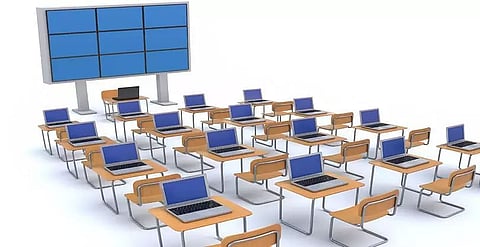
- Home
- Live Blog
- Breaking News
- Top Headlines
- Cities
- NE News
- Sentinel Media
- Sports
- Education
- Jobs

Disruption of normal academic activities on account of second wave of COVID-19 pandemic has put the spotlight on virtual classes. The Standard Operating Procedures (SOPs), issued by the Assam government to curb spread of the virus infection, make it mandatory for all educational institutions including schools/colleges/universities to provide quality virtual option for students. Access to internet continues to be the primary challenges in making online mode of classes accessible to all sections of student. The SOPs, therefore, allow the educational institutions to allow 50 per cent of students to attend on any day but preference is to be given in online mode of teaching for primary classes. Experiences of online classes during the first wave of pandemic last year showed that suspension of offline classes affected students in rural areas which do not have access to internet. Students of downtrodden families who could not afford to buy a smartphone also could not attend the online classes and lagged behind other students who could attend the classes. Protecting the students from COVID-19 infection tops the priorities of any government. Complete shutting down of educational institutions remains as the last resort for the government if things go out of hand. Worst-hit states have resorted to that option and online classes have become only the only mode of teaching in those states. Online teaching mode have multiple challenges for teachers as well as students. While some teachers and some students have means of large screen desktop or laptops for teaching and learning, majority of the students can access it only with the help of small screens of smartphones. Exposure to smartphone as well as computer screens for long hours during online classes strain the eyes besides causing headaches and fatigues. Unpredictability of COVID-19 pandemic situation has made it difficult to predict for how long the online mode of teaching will continue as the new normal of education. Unlike classroom environment, the scope of interaction between teachers and students as in offline classes are limited in online mode. Absence of interactions make the online classes dull and difficult for students to comprehend new lessons and topics as the opportunity to get their doubts clarified remain limited. For the teachers and education department, colleges, and universities the challenge is to produce quality teaching learning material for online mode of teaching which makes best use of digital technology to make the virtual classrooms interesting and engaging for students. The lectures delivered in face-to-face classroom environment replicated in online mode fail to engage students if these are not accompanied by adequate explanatory demonstrative materials ideal for digital platforms. Online classes cannot be lecture-heavy, but teachers need support of technical persons to push technology boundary to prepare the right content. Education department, universities roping in experts of the National Informatics Centres, Assam Electronics Development Corporation Limited in providing digital solutions that can make the online classes engaging and interactive can make virtual classrooms lively. For the students in areas not having internet access, radio and television have been used for online learning. Radio is the one such communication medium through which knowledge can be accessed even by those who have not attended formal classroom education or never learnt to read and write. Radio script requires excellent skills of writing for the ears. The teachers trained to teach in physical classroom environment cannot be expected to posses the skill of writing for the ears while the audio content of online classes will fail to connect with the students attending classes broadcast through radio. Expertise of Radio station staff who are skilled in perfect communication for radio listeners can be used to enhance the content of teaching material and make the classes interesting for students. Likewise, students watching educational content delivered by their teachers through television mode will expect more visuals. The script of classes for television mode requires writing for the eyes and ears both and must include adequate footages to keep the students engaged. Telecasting the video of a teacher delivering a lecture in a classroom cannot be expected to be engaging for all students. One way of overcoming the problem is to support the lectures with sufficient video content that explain the subject and the topic and support the words in the lectures because that is how the television medium works for viewers. Teaching contents suitable for radio and television media can bridge the digital divide among the students which has become more prominent in the prevailing pandemic situation. Use of animations can make the virtual classes more enjoyable. The disruption in offline mode of teaching and learning on account of COVID-19 pandemic is going to be long drawn and hence solutions for online mode cannot be stop-gap arrangements. Solutions lie in effective use of both traditional and digital platforms to ensure quality education in virtual classrooms.